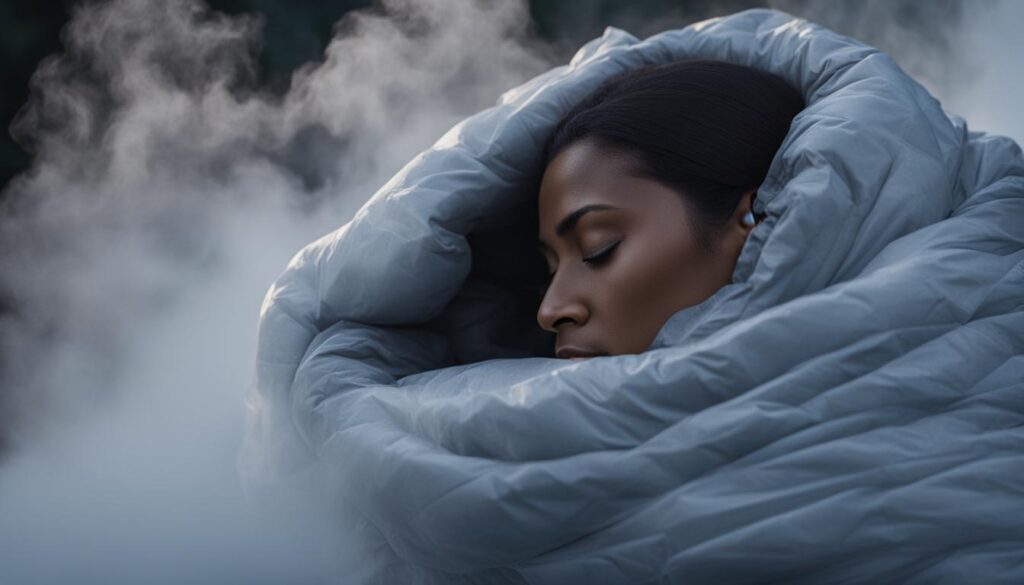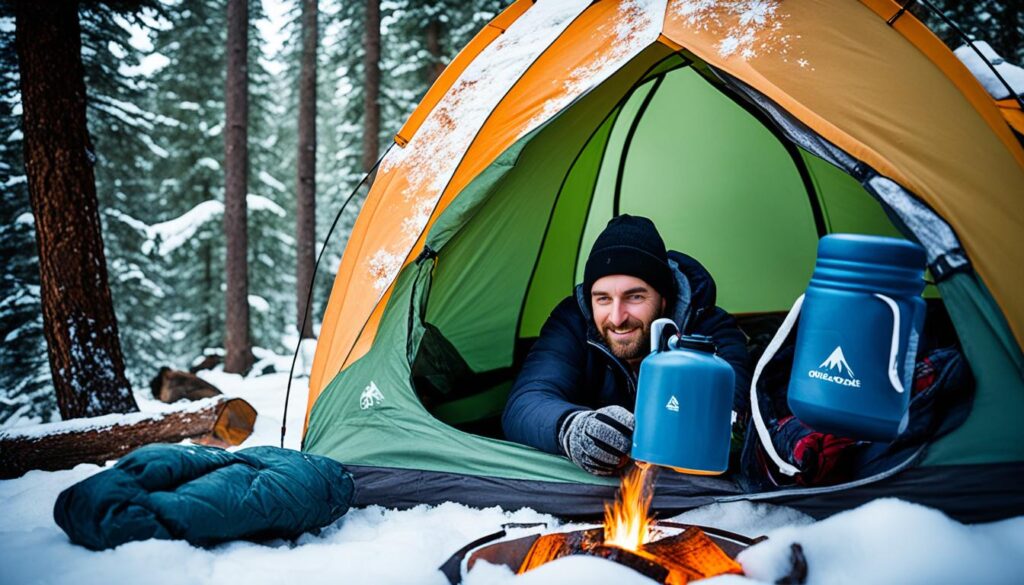Staying warm while camping in a tent is essential for a comfortable and enjoyable cold-weather adventure. With the right techniques and gear, you can stay cozy and warm even when the temperatures drop. In this article, we will explore essential techniques for staying warm in a tent based on expert advice from experienced campers and outdoor enthusiasts. Whether you are camping in the backcountry or at a drive-in campground, these tips will help you stay warm and comfortable throughout your camping trip.
Key Takeaways:
- Choose the right tent size and type for easier heating.
- Pick a campsite sheltered from the wind to prevent cold drafts.
- Combat condensation by pitching your tent tightly and venting it properly.
- Bring a warm sleeping bag that suits the expected temperature.
- Use an insulated sleeping pad to prevent cold ground from affecting your warmth.
Contents
Choose the Right Tent
When it comes to staying warm while camping, choosing the right tent is key. The type and size of tent you select can greatly impact your comfort level in colder temperatures. Opting for smaller tents, such as two- or three-person tents, makes it easier to heat the interior space. These tents have less air volume to warm up, allowing for quicker and more efficient heating. Additionally, smaller tents help retain heat better, as there is less open space for warmth to escape.
Another important factor to consider is the seasonality of the tent. Four-season tents are specifically designed for winter camping and are equipped to handle harsh weather conditions. They are constructed with fewer mesh panels, which helps keep cold air out and warm air in. However, unless you regularly engage in backcountry winter camping, a three-season tent will typically suffice.
Here’s a comparison of small tents and four-season tents:
| Small Tents | Four-Season Tents |
|---|---|
| Easier to heat due to smaller interior space | Built for winter camping |
| Retain heat better | Fewer mesh panels to keep cold air out |
| Suitable for general camping | Can withstand harsh weather conditions |
Ultimately, choosing a tent that suits your camping needs is essential for staying warm and comfortable. While small tents are more energy-efficient to heat, four-season tents provide added protection against the elements. Consider the type of camping you’ll be doing and the expected weather conditions to make an informed decision.
Remember, a warm and cozy tent is the starting point for a comfortable camping experience. By selecting the right tent, you can create a welcoming and insulated shelter where you can retreat from the cold and enjoy a restful night’s sleep.
Pick a Good Campsite
The location of your campsite can significantly impact your ability to stay warm while camping. It is important to choose a campsite that is sheltered from the wind to prevent cold drafts from entering your tent. Look for areas with natural features like trees or ridges that can provide additional protection from the wind. Additionally, selecting a campsite that receives morning sun can help warm up your tent and make it easier to get out of bed in the morning. Finally, camping at lower elevations can help you avoid colder temperatures often experienced at higher elevations.

| Factors to Consider | Importance | Tips |
|---|---|---|
| Protection from Wind | High | Choose a campsite that is shielded by natural features like trees or ridges to block the wind. |
| Morning Sun | Medium | Look for a campsite that receives ample morning sun to warm up your tent and provide a comfortable waking environment. |
| Lower Elevation | Low | Camp at lower elevations to avoid colder temperatures often experienced at higher elevations. |
Fight Condensation
Condensation can be a major concern when camping in cold weather as it can lead to a damp and cold sleeping environment. To fight condensation and ensure a comfortable camping experience, there are a few important steps to follow:
- Pitch your tent tightly: When setting up your tent, make sure to pitch it tightly by tightening all attachment points and staking it out properly. This will create a taut structure that allows moisture to pass through the tent’s mesh or fabric panels.
- Vent your tent: Proper ventilation is key in reducing condensation build-up. Leave a vent open, such as a vent over the door or in the roof, to allow moisture to escape. This will help maintain a drier and warmer sleeping environment.
By pitch your tent tightly and venting it properly, you can minimize condensation and enjoy a cozy and comfortable night’s sleep. Remember, a dry tent is a warm tent, so take these steps to ensure optimal camping conditions.

Bring a Warm Sleeping Bag
Your sleeping bag is your primary source of insulation and plays a vital role in keeping you warm while camping. When choosing a sleeping bag, consider its temperature rating, which indicates the lowest temperature at which it can keep you comfortable. Look for a sleeping bag with a comfortable rating that is suitable for the coldest temperature you expect to encounter.
To provide additional warmth, opt for a sleeping bag with a hood and draft collar. The hood helps insulate your head and prevents heat loss, while the draft collar seals the opening near your neck, minimizing any cold air from entering the bag. These features are especially important during chilly nights, ensuring that you stay snug and cozy throughout your camping adventure.
Proper fitting of your sleeping bag is also essential to maximize its insulating properties. A sleeping bag that is too large will leave empty space that needs to be heated, resulting in decreased warmth. Conversely, a bag that is too tight can restrict movement and potentially compress the insulation, reducing its effectiveness. Therefore, choose a sleeping bag that fits your body type properly, allowing for comfort and efficient heat retention.
If you anticipate extremely cold conditions or want extra warmth, consider adding layers to your sleeping bag. A fleece liner or quilt can be used to supplement the insulation and provide an additional barrier against the cold. Layering allows you to adjust your sleeping bag’s warmth based on the temperature, ensuring you stay cozy even in harsh weather conditions.

Use an Insulated Sleeping Pad
In addition to a warm sleeping bag, using an insulated sleeping pad is crucial for staying warm while camping. When you lie down to sleep, the ground underneath you can act as a heat sink, drawing away your body heat and making you feel cold. That’s where an insulated sleeping pad comes in.
An insulated sleeping pad provides ground insulation, creating a barrier between your body and the cold ground. It helps to prevent heat loss and keeps you warm throughout the night. When choosing an insulated sleeping pad, pay attention to its R-value. The R-value measures the pad’s insulation capability, with higher values indicating better insulation. For colder temperatures, look for a sleeping pad with an R-value of 4 or higher.
It’s important to note that an insulated sleeping pad is a better option than an air mattress. While air mattresses may offer comfort and cushioning, they provide little to no insulation against the cold ground. Investing in a good insulated sleeping pad will ensure that the cold ground doesn’t affect your overall warmth and comfort while camping.
FAQ
What type of tent should I choose for staying warm while camping?
Opt for a smaller tent, such as a two- or three-person tent, as they are easier to heat. Additionally, consider a four-season tent designed for winter camping, as they have fewer mesh panels and are better equipped for cold weather.
What should I consider when picking a campsite for camping in cold weather?
Choose a campsite that is sheltered from the wind to prevent cold drafts. Look for areas with natural features like trees or ridges for additional protection. Also, select a campsite that receives morning sun to help warm up your tent. Camping at lower elevations can also help you avoid colder temperatures at higher elevations.
How can I prevent condensation in my tent while camping?
To combat condensation, make sure to pitch your tent tightly and stake it out properly. Ventilation is key, so leave a vent open, such as over the door or in the roof, to allow moisture to escape.
What should I look for in a warm sleeping bag?
Consider the temperature rating of the sleeping bag, which indicates the lowest temperature it can keep you comfortable. Look for a sleeping bag with a hood and draft collar for added warmth. Ensure the sleeping bag fits your body properly to minimize empty space. You can also add layers like a fleece liner or quilt for extra warmth.
Why is an insulated sleeping pad important for staying warm in a tent?
An insulated sleeping pad prevents the coldness of the ground from seeping into your body. Look for a sleeping pad with a high R-value, indicating its insulation capability. It is recommended to choose an insulated sleeping pad over an air mattress for better insulation.






